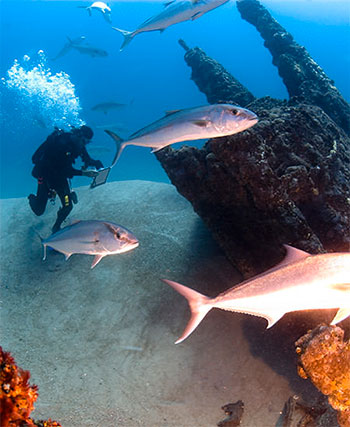Fishing Impacts
Monitor

Why is it a concern?
Fishing within and adjacent to the sanctuary may be a potential stressor to the wreck and associated artifacts at the site of the Monitor. Due to the fragile nature of the wreck, any impact as a result of activities such as anchoring or use of bottom fishing gear could cause considerable damage. Currently, live boat fishing is allowed within the sanctuary but Monitor National Marine Sanctuary regulations restrict anchoring or drifting while not under power within sanctuary boundaries.
While fishing within the sanctuary is almost exclusively recreational, there have been incidents involving commercial fishing gear that have caused serious damage to the sanctuary’s archaeological resources. In 1997, commercial fishing gear was found tangled on the Monitor. Also, during a 2004 NOAA and U.S. Navy expedition to the site, divers identified damage to the hull of the wreck and observed remains of a trawling net and long lines. Because there is not much commercial fishing that takes place inside sanctuary boundaries, the commercial fishing gear mentioned may potentially be derelict gear that has drifted into the sanctuary.
Overview of Research
While there have been accounts of fishing gear and/or fishing impacts in the sanctuary and on the wreck itself, no research has taken place to specifically survey and collect the gear and/or identify its origin. Neither has research taken place to quantify the amount of fishing that takes place within the sanctuary boundaries.
Science Needs and Questions
The best available science is used by Sanctuary scientists and managers working to address priority resource conservation and management issues. As priorities change and new issues emerge, each Sanctuary develops new science needs and questions and works with partners to address them.
- How much recreational and commercial fishing takes place within the sanctuary?
- Can fishing gear be found on the wreck site or within the sanctuary?
- What evidence of fishing impacts can be seen on the wreck itself? What is the cause?
- Where is the fishing gear or impact coming from?• What are the impacts of gear removal (biological and cultural)?
- What are the impacts of disregarding gear removal (biological and cultural)?
- Are there certain areas more susceptible to fishing impacts?
References
Gittings, S.R., M. Tartt, and K. Broughton. 2013. National Marine Sanctuary System Condition Report 2013. U.S. Department of Commerce, National Oceanic and Atmospheric Administration, Office of National Marine Sanctuaries, Silver Spring, MD. 33 pp.
NMSP (National Marine Sanctuary Program). 2008. Monitor National Marine Sanctuary Condition Report 2008. U.S. Department of Commerce, National Oceanic and Atmospheric Administration, Office of National Marine Sanctuaries, Silver Spring, MD. 33 pp.

